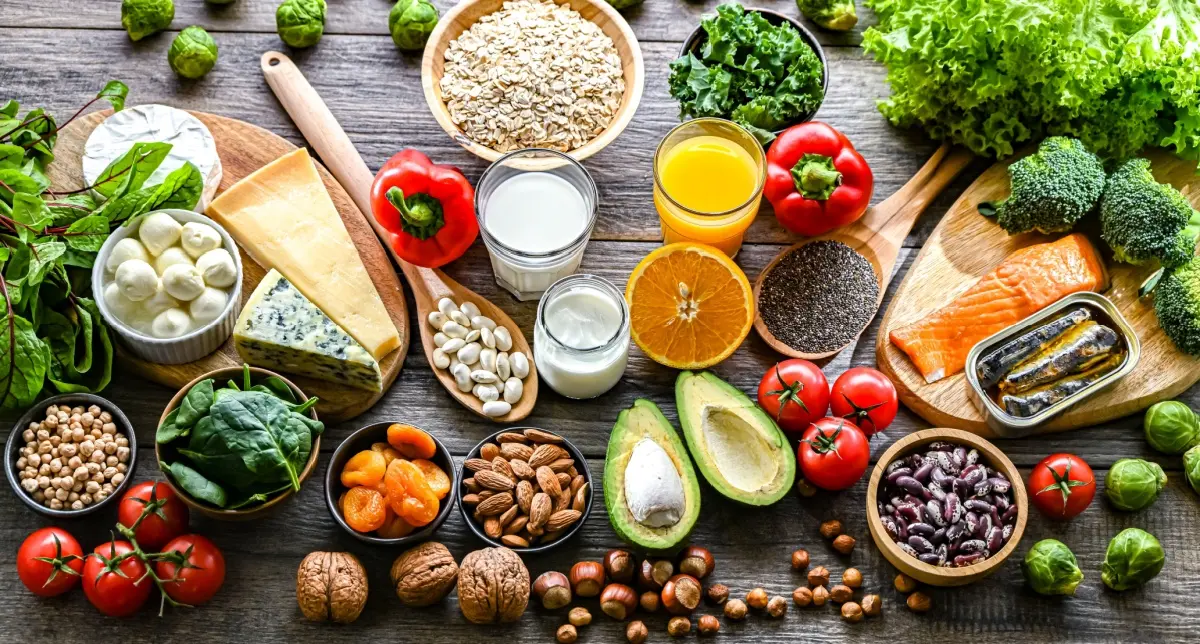Spinal cord injuries are among the most serious and life-altering injuries a person can sustain. The spinal cord, a complex bundle of nerves, is the primary pathway for communication between the brain and the rest of the body. When it’s damaged, a patient could be...
People who suffer from varicose veins, chronic venous insufficiency (CVI), and other related health conditions know that their symptoms involve more than just cosmetic concerns. They also frequently cause pain, swelling, and more serious health problems. For these...
Our smartphones, tablets, and laptops have connected us to the world in ways that we could never have imagined. We carry our offices, our social lives, and our entertainment with us everywhere we go. But this constant connectivity often comes with a trade-off, one...
Nutrition for Bone and Joint Health

The foods you eat affect much more than just your weight and energy levels; they also play a significant role in your long-term bone and joint health. That’s why having a balanced diet is essential. But what does a “balanced diet” consist of? It should include an array of vitamins and minerals, such as calcium, vitamin D, omega-3 fatty acids, and antioxidants. How you get these essential nutrients is all up to you! Whether you prefer yogurts and cheeses or leafy greens and hearty meats, for example, there’s an option that will delight your taste buds while still allowing you to get everything you need for healthy bones and joints.
If you’re trying to create a diet that prioritizes bone and joint health, this guide will help you understand which foods to include and how to incorporate them into your life.
Essential Nutrients for Bone and Joint Health
Let’s start with the basics. Your body needs various nutrients to function properly, and some of the most important include:
- Calcium and Vitamin D: Calcium is a major building block of bone tissue, while vitamin D helps your body absorb it. Without enough of both, your bones can become brittle and more prone to fractures.
- Magnesium: Magnesium works alongside calcium to ensure proper bone density.
- Vitamin K2: This vitamin helps direct calcium to the bones rather than letting it accumulate in soft tissues.
- Vitamin C: Vitamin C plays a major role in collagen production. Why is this important? Well, collagen is a protein that helps maintain joint cartilage.
- Omega-3 Fatty Acids: Omega-3 fatty acids, found in fatty fish like salmon and mackerel, are excellent for reducing joint inflammation and stiffness.
- Antioxidants: Antioxidants such as vitamin E and selenium protect your bones and joints from oxidative stress, which can lead to the breakdown of cartilage over time.
What to Eat to Strengthen Your Bones
Growing up, you may have heard that drinking milk builds strong bones. While dairy products like milk, yogurt, and cheese are indeed rich in calcium, they aren’t the only foods for bone and joint health. Let’s take a look at the top foods for strengthening bones.
Dairy Products
Dairy products are some of the most well-known sources of calcium, a mineral vital for building and maintaining strong bones. Many of our milks, yogurts, and cheeses are even fortified with vitamin D, which enhances calcium absorption.
Wondering how to add more dairy products to your life? Try making your breakfast with Greek yogurt (whether that includes adding it to a smoothie or simply eating a bowl of granola with yogurt), enjoying a cheese stick as a snack, or using milk in your smoothies and oatmeal.
Leafy Greens
If you prefer plant-based options or want to diversify your calcium intake, leafy greens are a smart choice. Vegetables like kale, bok choy, and spinach are packed with calcium and magnesium (which is another mineral essential for bone strength).
Toss some kale into soups, sauté bok choy as a side dish, or blend spinach into smoothies to get more greens into your routine. A little forethought when shopping and meal prepping can go a long way.
Seafood
Sardines and salmon, especially those with edible bones, are additional calcium-rich foods. They also provide vitamin D and omega-3 fatty acids, which support joint health and reduce inflammation. Enjoy sardines on whole-grain toast, or add grilled salmon to salads or grain bowls for a nutrient-dense meal that supports bone strength.
Cruciferous Vegetables
Broccoli may not get as much attention as dairy when it comes to bone health, but it’s an excellent source of calcium and vitamin C. Steam broccoli as a dinner side, roast it with olive oil and garlic, or chop it up for a vibrant veggie stir-fry.
Whole Grains, Tofu, and Legumes
These foods are rich in minerals like zinc and copper, which assist in bone formation and repair. Tofu, especially calcium-set varieties, is a fantastic option for those avoiding animal products. Include chickpeas in your salads, enjoy black beans in tacos, or opt for a quinoa bowl topped with grilled tofu for a complete, bone-nourishing meal.
Fruits
Vitamin C-rich fruits such as oranges, strawberries, and pineapples play a role in collagen production and overall bone maintenance. Prunes, in particular, have shown promise in preventing bone loss.
Want to add more fruits to your diet? Put citrus fruits in your salads, snack on berries, or pair your midday snack with a handful of dried prunes for a sweet treat that supports your bones.
Anti-Inflammatory Foods for Joint Pain
Ever woken up with aching joints and wondered if something in your diet might be to blame? Inflammation is a key player in joint pain and arthritis, and certain foods can either fuel or fight the inflammatory process. For example, processed foods, added sugars, and trans fats could promote inflammation and worsen joint pain over time. So, instead of eating highly processed foods, consider focusing on whole, nutrient-dense options that calm inflammation and contribute to your overall joint health. These options include:
Fatty Fish
Fatty fish like salmon, tuna, and mackerel are some of the best foods for joint health. This is because they are high in omega-3 fatty acids, which are known to reduce inflammation and ease joint stiffness.
Including fish in your diet two to three times per week can have noticeable benefits. Try grilled salmon with roasted vegetables or tuna salad made with an olive oil-based dressing to get your omega-3s in a delicious way.
Colorful Fruits
Berries such as blueberries, strawberries, and raspberries are rich in antioxidants like polyphenols and vitamin C. These nutrients work together to fight inflammation and protect your joints from oxidative stress. A morning smoothie with mixed berries or a bowl of fresh fruit as a snack can be an easy way to incorporate these joint-friendly fruits into your diet.
Nuts and Seeds
Walnuts, flaxseeds, and chia seeds pack a powerful anti-inflammatory punch thanks to their high content of healthy fats, fiber, and antioxidants. Adding a handful of walnuts to your oatmeal, blending chia seeds into your smoothies, or sprinkling flaxseed on salads can support joint function and help minimize inflammation.
Olive Oil and Healthy Fats
Extra virgin olive oil is a staple in the Mediterranean diet and contains compounds that mimic the effects of anti-inflammatory medications. It can be used in salad dressings, for sautéing vegetables, or drizzled over roasted dishes. Replacing butter or vegetable oil with olive oil is a simple and tasty way to protect your joints.
Spices and Herbs
Turmeric and ginger are two spices celebrated for their anti-inflammatory properties. Curcumin, the active compound in turmeric, and gingerol, found in ginger, both have been shown to alleviate joint pain. You can add turmeric to soups, stews, and rice dishes, or enjoy ginger as a tea, in smoothies, or in stir-fries.
Whole Grains
Whole grains such as brown rice, quinoa, and oats help reduce levels of C-reactive protein (CRP), a marker of inflammation in the body. Opt for oatmeal at breakfast, a quinoa salad for lunch, or brown rice with dinner to incorporate these inflammation-fighting grains into your meals.
Experiencing Joint Pain or Discomfort? Call Premier Orthopaedics
Your journey to healthier bones and joints doesn’t need to be complicated. By including a range of nutrient-dense foods in your diet, you can support your musculoskeletal system with ease.
Of course, it’s important to note that nutrition alone may not be enough if you’re already experiencing discomfort. If you’re feeling any pain in your hands, wrists, elbows, shoulders, hips, knees, ankles, or feet, visit a specialist for a professional evaluation.
At Premier Orthopaedics, we’re here to help you get to the bottom of your pain. We can provide a proper diagnosis, recommend effective treatment options, and guide you in building a diet that supports your specific condition.
Whether you’re managing arthritis, recovering from a sports injury, or looking to prevent future problems, we can work with you to create a plan that supports both your medical and nutritional needs. Contact Premier Orthopaedics today to schedule a consultation and take the first step toward stronger bones, healthier joints, and a better quality of life.
